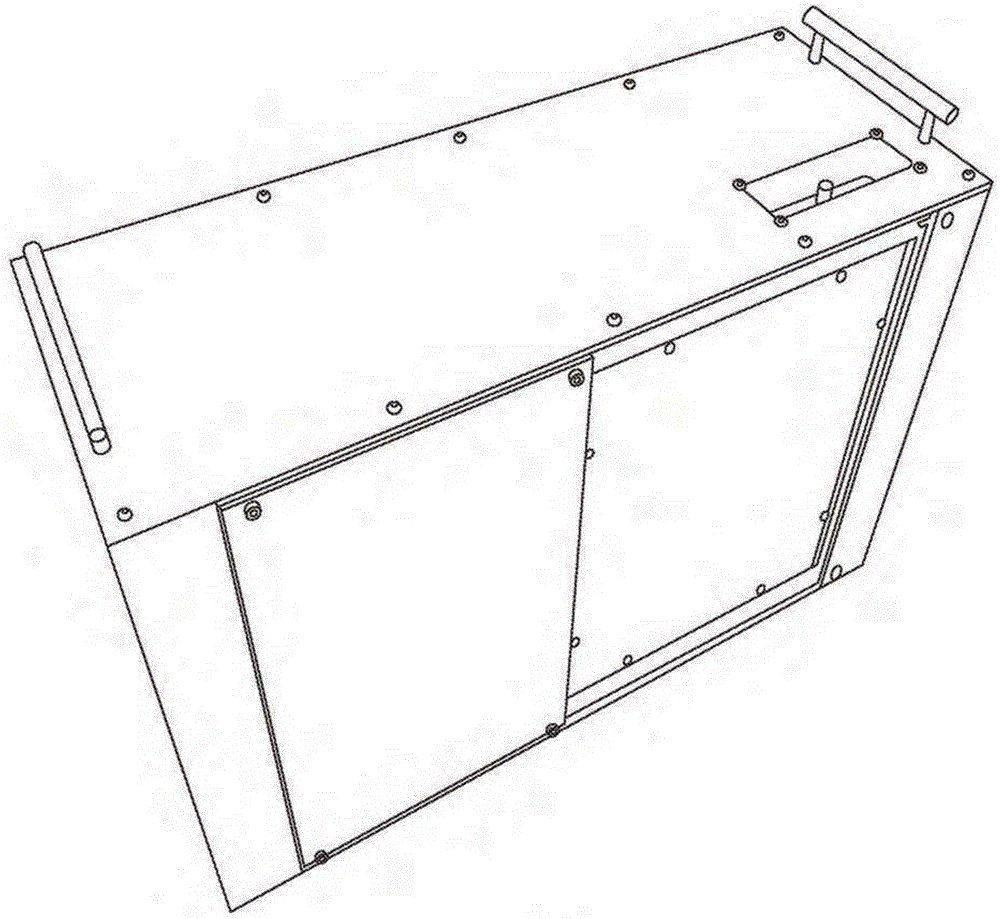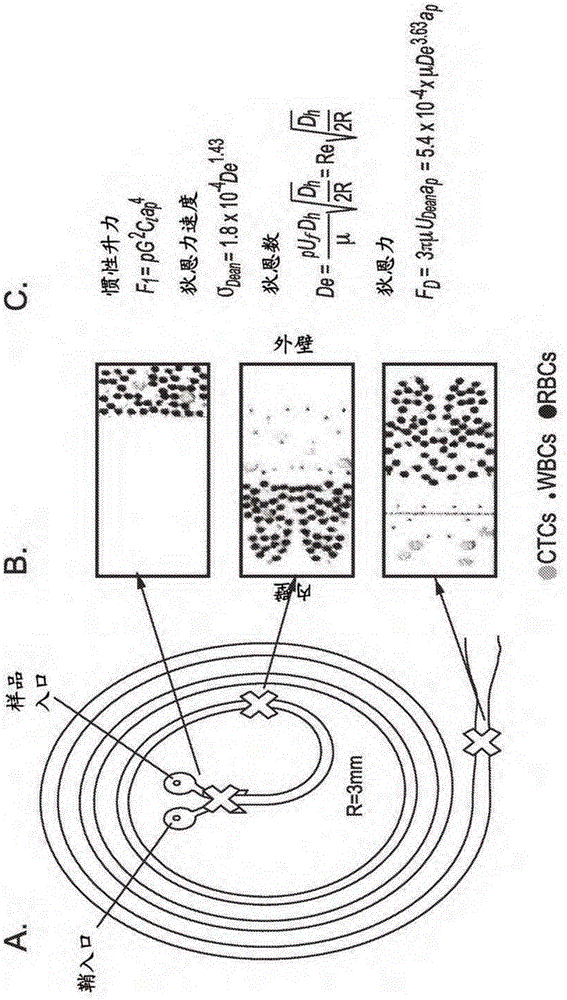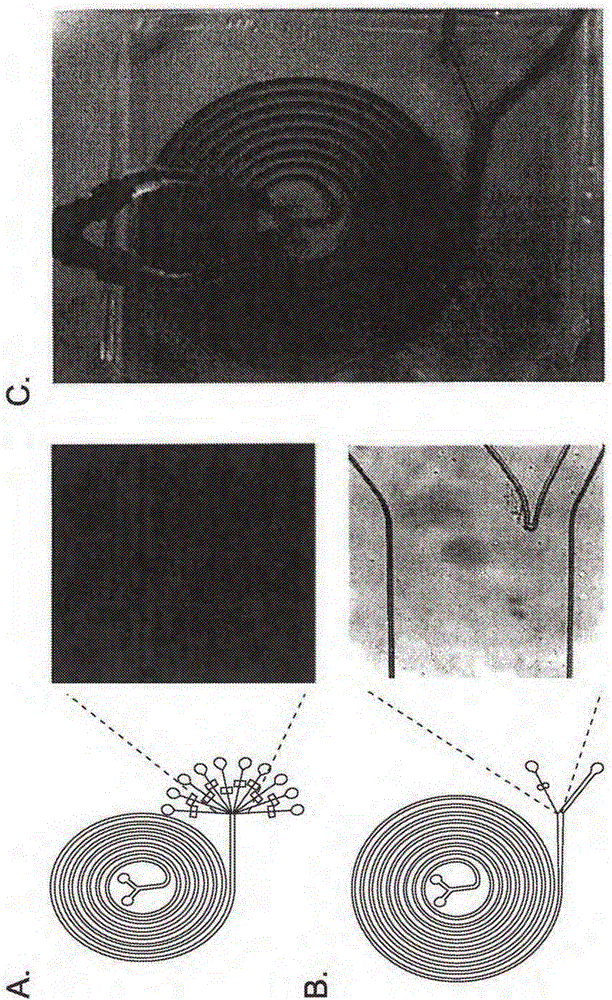Systems, apparatus, and methods for sorting particles
A detection system, a branched technology, applied in the implementation of digital logic, culturing cells alone, numbering, sending fluids, pumping fluids, and determining the best response strips, and indeed, the system is also part of the field of light, which can solve expensive, FACS utilization limitations, difficult to manufacture and operate and other issues
- Summary
- Abstract
- Description
- Claims
- Application Information
AI Technical Summary
Problems solved by technology
Method used
Image
Examples
example 1
[0374] Example 1: First-stage CTC enrichment using a hydrodynamic microfluidic device.
[0375] The hydrodynamic properties can be used to obtain 100-fold or higher enrichment of CTCs prior to microFACS sorting (see Example 3). In an effort to achieve >100-fold enrichment, several helical channel devices were designed. Several helical enrichment structures were designed for the first-stage enrichment of CTCs. The helical device structure takes advantage of the physical properties of cells under laminar flow conditions, where inertial lift and Dean forces allow focusing and separation of cells. The balance between inertial lift and Dean's force allows balancing position for any type of sample based on size. This protocol results in efficient separation of target large cells from a mixture of smaller cells. The general structure and concept are shown in figure 2 A-2C, which has approximate dimensions. In the first step, a mixture of cells of different sizes (eg, CTCs in bl...
example 2
[0382] Example 2: Hydrodynamically assisted CTC-binding antibody
[0383] The design was tested in which antibodies were added to cancer cells and the mixture was injected through a hybrid structure to achieve rapid and efficient cell labeling. Several commercially available antibodies were tested against EpCAM, an epithelial marker of CTCs. The results indicated that samples could potentially be labeled by the hybrid architecture disposable chip in 1-2 minutes (compared to 20-60 minutes). This approach is possible in the OncoSorter system due to the disposable nature of the chip used in the microfluidic detector system. Initial tests showed excellent labeling efficiency. In some embodiments, the microfluidic detector system is automated and adapted for use in a clinical setting where there are no scientists trained in cell handling and flow cytometry.
[0384] Fluid dynamics simulation software is used to design and analyze the hybrid structure to improve the binding effic...
example 3
[0388] Example 3: Benchtop Microfluidic Detector for CTC Isolation
[0389] Microfluidic detectors were developed to complete the enumeration and isolation of CTCs. In some cases, in-house designed microfluidic fluorescence-activated cell sorters (microfluidic detectors) were modified for CTC isolation and analysis. A design modification of the alpha prototype maximizes collection efficiency to ensure that nearly all CTCs are sorted. AutoCAD designs were generated to fabricate microfluidic detectors using PDMS in the Nano3 and at the Lo lab at UCSD ( Figure 10 A-B). The main channel was designed to be 200 microns wide and split into three 50 micron sample collection channels with a height of 80 microns. Chip holders are also designed to allow for Figure 10 C) chip replacement. The holder ensures precise alignment of the microfluidic channels with the optical axis by using alignment marks already implemented into the device, thereby eliminating any potential fluctuations...
PUM
| Property | Measurement | Unit |
|---|---|---|
| length | aaaaa | aaaaa |
| length | aaaaa | aaaaa |
| length | aaaaa | aaaaa |
Abstract
Description
Claims
Application Information
 Login to View More
Login to View More - R&D
- Intellectual Property
- Life Sciences
- Materials
- Tech Scout
- Unparalleled Data Quality
- Higher Quality Content
- 60% Fewer Hallucinations
Browse by: Latest US Patents, China's latest patents, Technical Efficacy Thesaurus, Application Domain, Technology Topic, Popular Technical Reports.
© 2025 PatSnap. All rights reserved.Legal|Privacy policy|Modern Slavery Act Transparency Statement|Sitemap|About US| Contact US: help@patsnap.com



